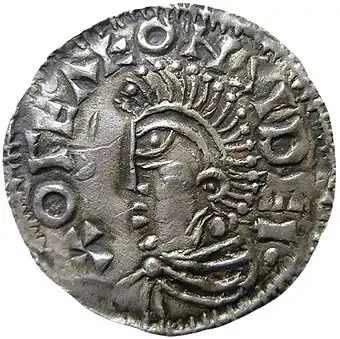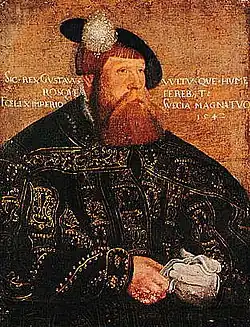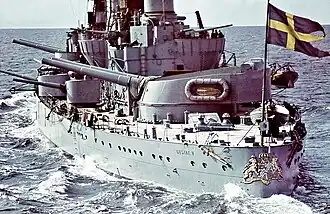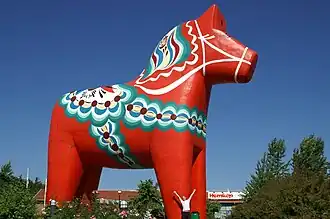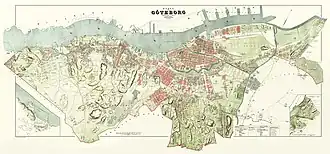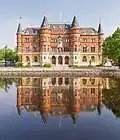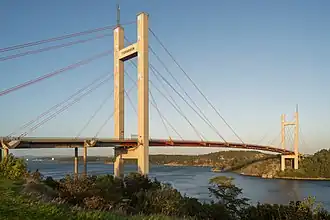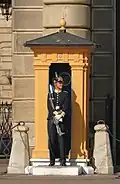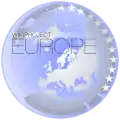Portal:Sweden
Welcome to the Sweden Portal! | ||||||||||||
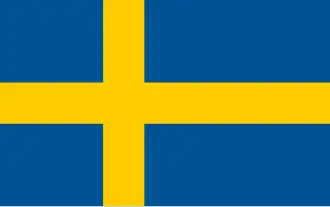
|
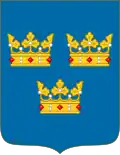
|
.svg.png)
| |
Sweden, formally the Kingdom of Sweden, is a Nordic country located on the Scandinavian Peninsula in Northern Europe. It borders Norway to the west and north, and Finland to the east. At 450,295 square kilometres (173,860 sq mi), Sweden is the largest Nordic country by both area and population, and is the fifth-largest country in Europe. Its capital and largest city is Stockholm. Sweden has a population of 10.6 million, and a low population density of 25.5 inhabitants per square kilometre (66/sq mi); 88% of Swedes reside in urban areas. They are mostly in the central and southern half of the country. Sweden's urban areas together cover 1.5% of its land area. Sweden has a diverse climate owing to the length of the country, which ranges from 55°N to 69°N.
Sweden has been inhabited since prehistoric times around 12,000 BC. The inhabitants emerged as the Geats (Swedish: Götar) and Swedes (Svear), who formed part of the sea-faring peoples known as the Norsemen. A unified Swedish state was established during the late 10th century. In 1397, Sweden joined Norway and Denmark to form the Scandinavian Kalmar Union, which Sweden left in 1523. When Sweden became involved in the Thirty Years' War on the Protestant side, an expansion of its territories began, forming the Swedish Empire, which remained one of the great powers of Europe until the early 18th century. During this era Sweden controlled much of the Baltic Sea. Most of the conquered territories outside the Scandinavian Peninsula were lost during the 18th and 19th centuries. The eastern half of Sweden, present-day Finland, was lost to Imperial Russia in 1809. The last war in which Sweden was directly involved was in 1814, when Sweden by military means forced Norway into a personal union, a union which lasted until 1905.
Sweden is a highly developed country ranked fifth in the Human Development Index. It is a constitutional monarchy and a parliamentary democracy, with legislative power vested in the 349-member unicameral Riksdag. It is a unitary state, divided into 21 counties and 290 municipalities. Sweden maintains a Nordic social welfare system that provides universal health care and tertiary education for its citizens. It has the world's 14th highest GDP per capita and ranks very highly in quality of life, health, education, protection of civil liberties, economic competitiveness, income equality, gender equality and prosperity. Sweden joined the European Union on 1 January 1995 and NATO on 7 March 2024. It is also a member of the United Nations, the Schengen Area, the Council of Europe, the Nordic Council, the World Trade Organization and the Organisation for Economic Co-operation and Development (OECD). (Full article...)
 Good article -
Good article -
Anna Elisabeth Johansson Bågenholm (born 1970) is a Swedish radiologist from Vänersborg, who survived after a skiing accident in 1999 left her trapped under a layer of ice for 80 minutes in freezing water. During this time she experienced extreme hypothermia and her body temperature decreased to 13.7 °C (56.7 °F), one of the lowest survived body temperatures ever recorded in a human with accidental hypothermia. Bågenholm was able to find an air pocket under the ice, but experienced circulatory arrest after 40 minutes in the water.
After rescue, Bågenholm was transported by helicopter to the Tromsø University Hospital, where a team of more than a hundred doctors and nurses worked in shifts for nine hours to save her life. Bågenholm woke up ten days after the accident, paralyzed from the neck down and subsequently spent two months recovering in an intensive care unit. Although she has made an almost full recovery from the incident, late in 2009 she was still having minor symptoms in hands and feet related to nerve injury. Bågenholm's case has been discussed in the leading British medical journal The Lancet, and in medical textbooks. (Full article...)
Selected article -
Queen of the Clouds is the debut studio album by Swedish singer Tove Lo, released on 24 September 2014 by Island Records. The album follows her first extended play Truth Serum (2014) and includes the successful singles "Habits (Stay High)" and "Talking Body". Lo worked with several writers and producers such as The Struts, Klas Åhlund, Alexander Kronlund, Alx Reuterskiöld, and Captain Cuts. Musically, Queen of the Clouds is primarily a electropop, dance-pop and synth-pop record. Lyrically, the album's themes center on the stages of a relationship, including passion, love, and breaking up.
Queen of the Clouds garnered generally positive reviews from music critics, who praised its production and lyrical content. It was promoted with television performances and through the Queen of the Clouds Tour. On 25 September 2015, a year after the album's original release, a "blueprint" edition was announced; the bonus length features tracks from Truth Serum, a new version of "Moments", the originally Spotify-exclusive "Not Made for This World", and an explicit version of The Hunger Games: Mockingjay – Part 1's "Scream My Name". On 27 September 2024, a reissue (subtitled X) was released to commemorate the album's tenth anniversary. It includes a new interlude, two new songs, "Jealousy" and "Write Me Off," and a new remix of "Talking Body." (Full article...)
Did you know -

- ... that Lapland school founder Maria Magdalena Mathsdotter turned to Erik Viktor Almquist to improve the rights of the Sami people?
- ...that Sweden didn't have an official language until 2009?
- ... that the 19th-century Klabböle hydroelectric power plant in northern Sweden is now a museum?
General images -
 Featured article -
Featured article -
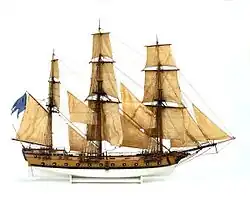
A hemmema (from Finnish "Hämeenmaa", Tavastia) was a type of warship built for the Swedish archipelago fleet and the Russian Baltic Fleet in the late 18th and early 19th centuries. The hemmema was initially developed for use against the Imperial Russian Navy in the Archipelago Sea and along the coasts of Svealand and Finland. It was designed by the prolific and innovative Swedish naval architect Fredrik Henrik af Chapman (1721–1808) in collaboration with Augustin Ehrensvärd (1710–1772), an artillery officer and later commander of the Swedish archipelago fleet. The hemmema was a specialized vessel for use in the shallow waters and narrow passages that surround the thousands of islands and islets extending from the Swedish capital of Stockholm into the Gulf of Finland.
The hemmema replaced the galleys that had made up the core of the Swedish archipelago fleets until the mid-18th century. Compared to galleys, the hemmema had a deeper draft and was slower under oars, but offered superior accommodation for the crew, carried more stores, was more seaworthy and had roughly ten times as many heavy guns. It could be propelled by either sails or oars but was still smaller and more maneuverable than most sailing warships, which made it suitable for operations in confined waters. (Full article...)
 Featured picture -
Featured picture -
Categories

Main topics
Subdivisions: Counties of Sweden • Municipalities of Sweden • Provinces of Sweden

History: 1975 Occupation of the West German embassy • Ådalen shootings • Consolidation of Sweden • Early Swedish history • Enlightened Absolute Monarchy in Sweden • Early Vasa era • Industrialization of Sweden • Post-war Sweden • Prehistoric Sweden • Rise of Sweden as a Great Power • Suiones • Swedish Empire • Sweden after the Great Northern War • Sweden and the Winter War • Sweden during late 19th century • Sweden during World War II • Swedish allotment system • Swedish emigration to the United States • Union between Sweden and Norway
Politics: Alliance for Sweden • Constitution of Sweden • Foreign relations of Sweden • Government of Sweden • Parliament of Sweden • Riksdag • Swedish general election, 2006 • Swedish general election, 2010 • Swedish neutrality • Swedish welfare
Demographics: Education • Ethnic minorities • Languages • Religion • Subdivisions • Cities • People • Healthcare • Immigration
Culture: Cinema of Sweden • Cuisine of Sweden • Music of Sweden • Sports in Sweden • Swedish literature • Tourism in Sweden
Symbols: Flag • Coat of arms • National anthem
Things you can do
 |
Here are some tasks awaiting attention:
|
Wikipedia in Swedish
 |
There is a Swedish version of Wikipedia, the free encyclopedia. |
 |
WikiProjects
|
|
|
|
Featured and good content
Related portals
Northern Europe
Other countries
Associated Wikimedia
-
 List of all portals
List of all portals -

-

-

-
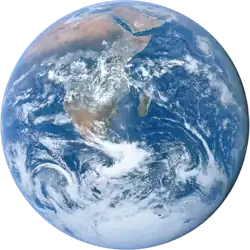
-

-

-

-

-

-
 Random portal
Random portal -
 WikiProject Portals
WikiProject Portals

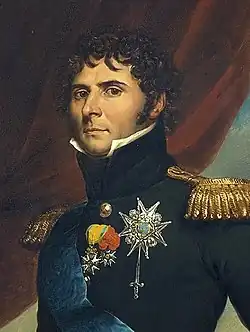
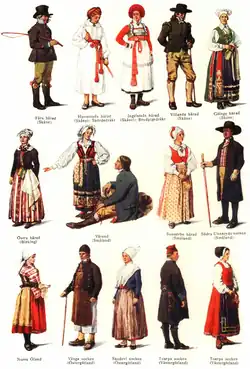


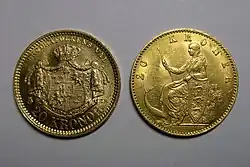
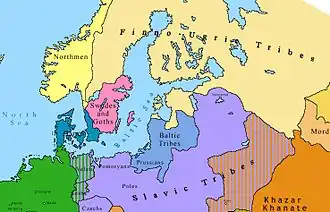
.jpg)


.svg.png)
